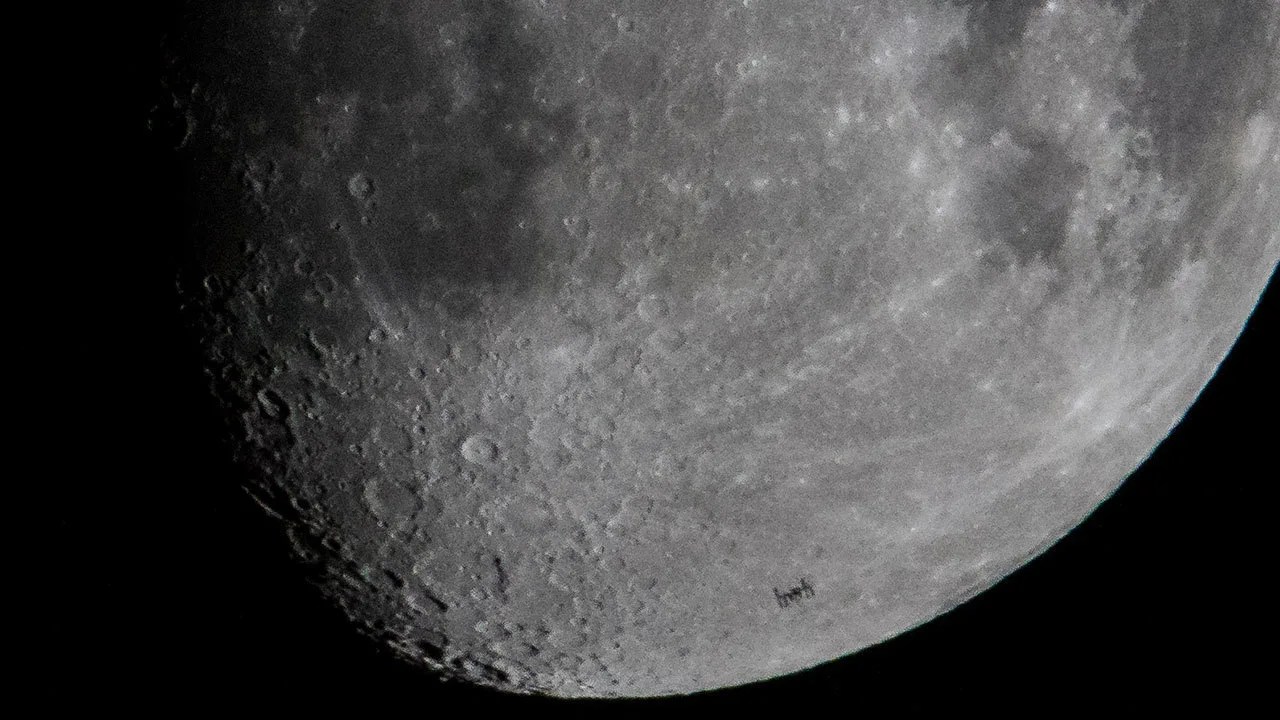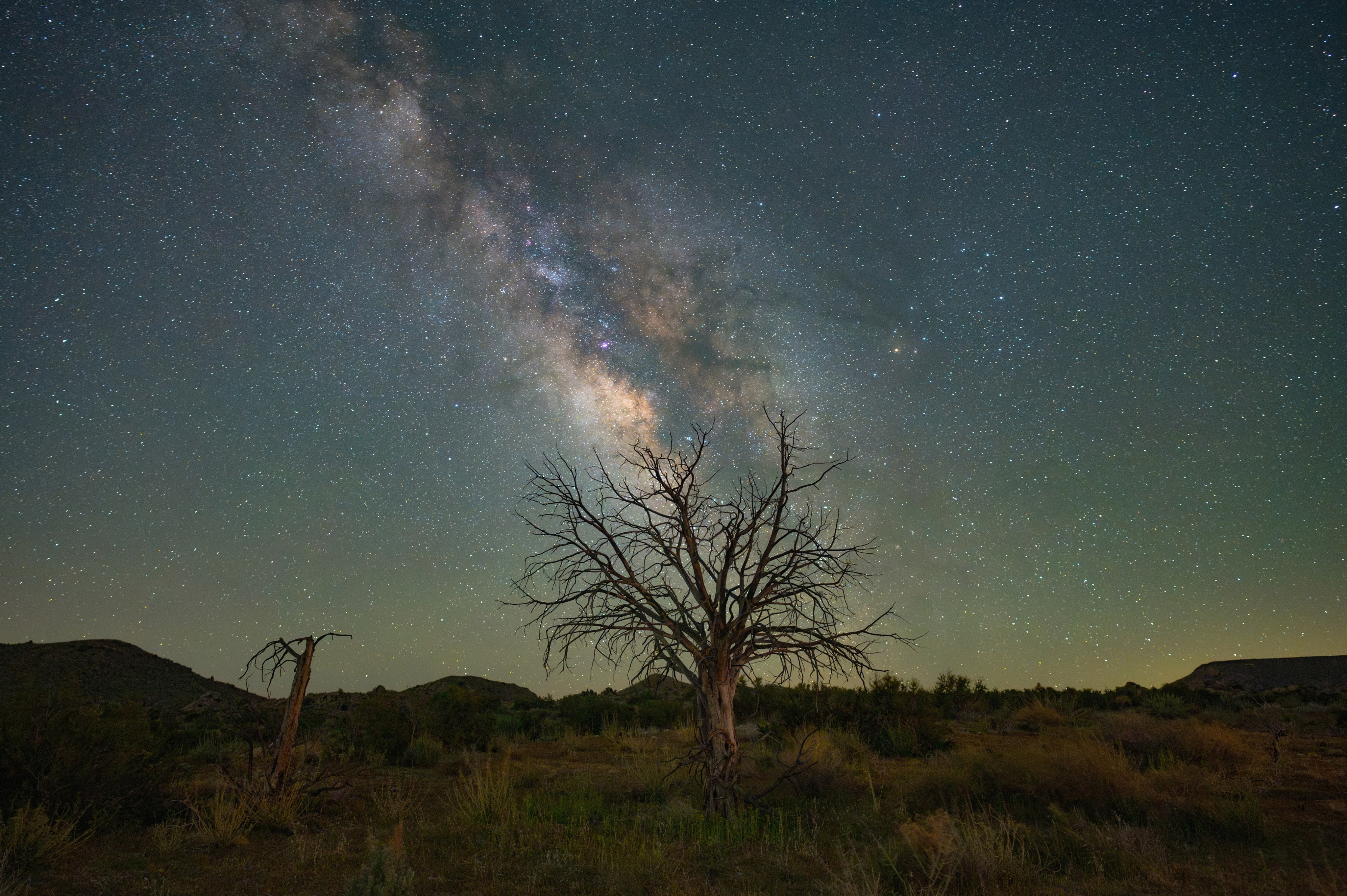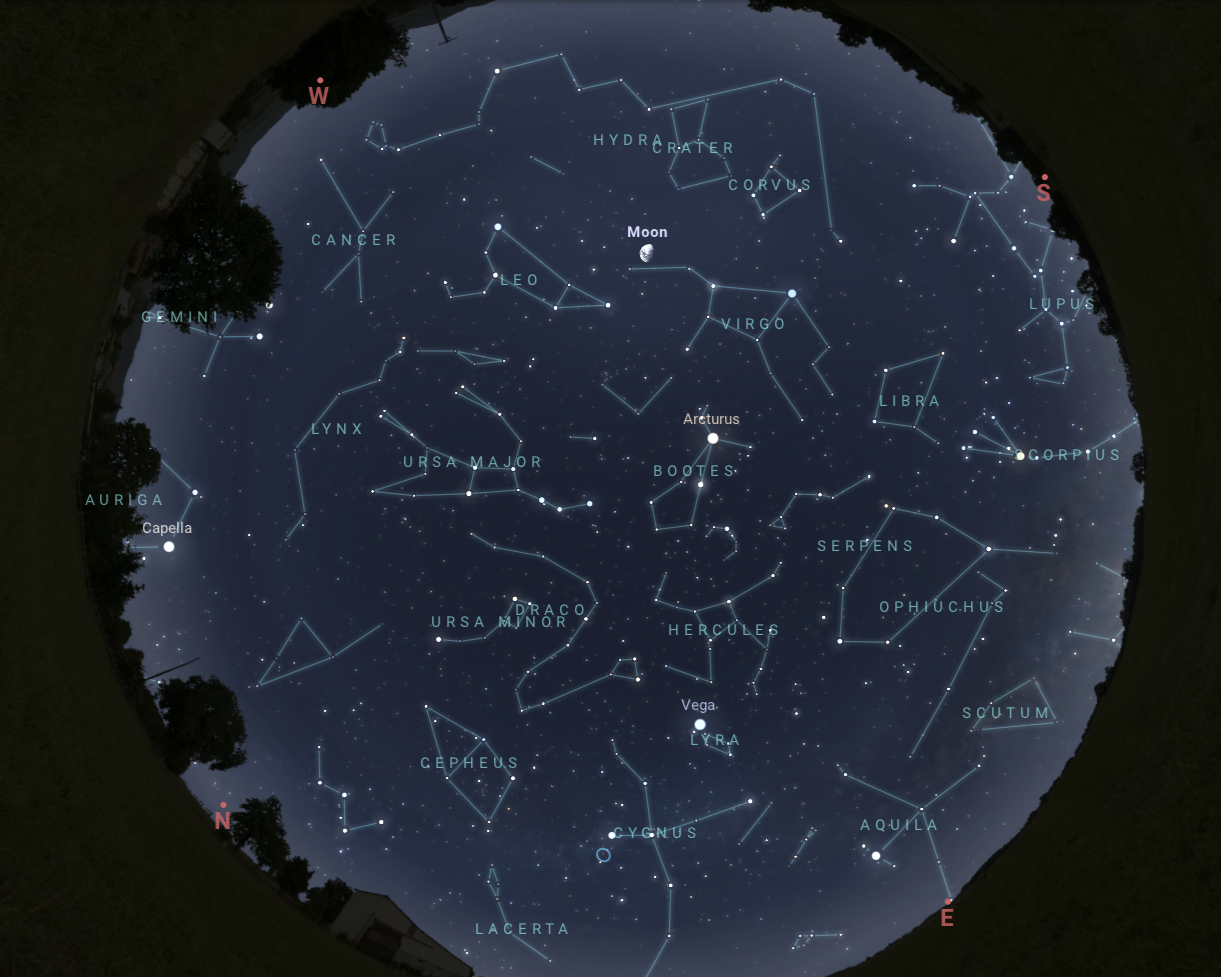15 min read

The Next Full Moon is the Wolf Moon, Ice Moon, the Moon after Yule, Shakambhari Purnima, Paush Purnima, and Duruthu Poya.
The next full Moon will be on Friday afternoon, January 10, 2020, appearing opposite the Sun (in Earth based longitude) at 2:21 p.m. EST. The Moon will appear full for about three days centered on this time, from Thursday morning to Sunday morning. As the Moon passes opposite the Sun it will spend about four hours in the partial shadow of Earth. This will be while the Moon is below the horizon for most of the Americas. If you happen to find yourself on the opposite side of Earth, the slight and gradual dimming of the Moon should be barely noticeable (if at all).
The Maine Farmer's Almanac first published Indian names for the full Moons in the 1930s. According to this almanac, the Algonquin tribes of what is now the northern and eastern United States named the full Moon in January or the first full Moon of winter the Wolf Moon, from the packs of wolves that howled hungrily outside the villages amid the cold and deep snows of winter. Another name is the Ice Moon. Europeans called this the Moon after Yule. Yule was a three-day winter solstice festival in pre-Christian Europe. In the 10th Century King Haakon I associated Yule with Christmas as part of the Christianization of Norway, and this association has spread throughout the countries that follow European traditions. In the Hindu calendar this full Moon is Shakambhari Purnima, the last day in the eight-day Shakambari Navratri holiday that celebrates the goddess Shakambhari. In the Purnimanta tradition that ends the months on the on full Moon day, this full Moon (purnima) is Paush Purnima, the last day of the Hindu month Paush. The day after Paush Purnima is the start of the month Magha, a period of austerity. Bathing in the holy waters of India is an important activity for both Shakambari Navratri and Magha. For the Buddhists of Sri Lanka, this is Duruthu Poya, which commemorates Siddhartha Gautama Buddha's first visit to Sri Lanka.
In most lunisolar calendars the months change with the new Moon and full Moons fall in the middle of the lunar month. This full Moon is in the middle of Tevet in the Hebrew calendar and the twelfth month in the Chinese calendar, and Chinese New Year will occur with the New Moon later in January. In the Islamic calendar the months start with the first sighting of the waxing crescent Moon a few days after the New Moon. This full Moon is near the middle of Jumada al-awwal, the fifth month of the Islamic year.
As usual, the wearing of suitably celebratory celestial attire is encouraged in honor of the full Moon.
As winter begins, the daily periods of sunlight will begin to lengthen again. For the Washington, DC area, on the day of the next full Moon (January 10, 2020), daylight will last 9 hours, 38 minutes. Morning twilight will begin at 6:24 a.m. EST, sunrise will be at 7:27 a.m., the Sun will reach a maximum altitude of 29.2 degrees at 12:15:28 p.m., sunset will be at 5:05 p.m., and evening twilight will end at 6:07 p.m.. By the day of the full Moon after next (February 9, 2020), the period of daylight will be 53 minutes longer, lasting 10 hours, 31 minutes. Morning twilight will begin at 6:08 a.m., sunrise will be at 7:07 a.m., the Sun will reach a maximum altitude of 36.4 degrees at 12:22:16 p.m., sunset will be at 5:38 p.m., and evening twilight will end at 6:37 p.m.
On the evening of the full Moon as evening twilight ends, the brightest planet in the sky will be Venus, appearing as the evening star in the southwest about 19 degrees above the horizon. No particularly bright star will appear near overhead. The highest bright star will be Capella, appearing about 46 degrees above the northeastern horizon (and shifting to appear nearly overhead by 4 hours later in the evening). As the month progresses the background of stars will appear to shift toward the west, while Venus will appear to shift the other direction, higher in the sky each night. Toward the end of January, Mercury will begin to emerge from the glow of dusk in the west-southwest. By the evening of the full Moon after next, February 9, 2020, bright Venus will appear in the west-southwest at about 27 degrees above the horizon. Mercury will appear to the lower left of Venus at about 6 degrees above the horizon. The bright star Capella will appear high and to the northeast at about 72 degrees above the horizon, while Aldebaran and the other bright stars from the local arm of our home galaxy, including the constellation Orion, will appear spread out toward the southeast.
As morning twilight begins, the planet Mars will appear about 20 degrees above the southeastern horizon with the bright star Antares appearing below Mars. Antares is a reddish star similar in color to Mars. Ares is the Greek name for Mars and the name "Antares" is sometimes translated as "the rival of Mars" due to their similar appearance. As the month progresses the background of stars will appear to shift toward the west, with Mars shifting more slowly. Mars and Antares will appear closest to each other, less than 5 degrees apart, on the morning of January 18, 2020. In mid-January the planet Jupiter, appearing much brighter than Mars, will begin to emerge from the glow of dawn in the east-southeast. In early February, Saturn will begin to emerge in the east-southeast as well. By the morning of the full Moon after next on February 9, 2020, as morning twilight begins, Jupiter will be the brightest planet in the sky, appearing in the southeast at about 8 degrees above the horizon. Saturn will appear next in brightness to the lower left of Jupiter at about 2 degrees above the horizon. Lying roughly in line with Saturn and Jupiter, Mars will appear to the upper right of Jupiter at about 19 degrees above the horizon.
Even though they are not usually visible, I include in these Moon missives information about Near Earth Objects (mostly asteroids) that may pass Earth within 10 lunar distances, because I find it interesting that we have discovered so many. Early on Tuesday morning, Jan. 7, at 2:44 a.m. EST (2020-Jan-07 07:44 UTC with 4 minutes uncertainty), Near Earth Object (2020 AV1), between 17 and 38 meters (55 to 123 feet) in size, will pass Earth at between 7.2 and 7.3 lunar distances (nominally 7.2), traveling at 12.06 kilometers per second (26,980 miles per hour).
On Tuesday evening into Wednesday morning, January 7 to 8, the bright star appearing near the waxing gibbous Moon will be Aldebaran. For the Washington, DC area, as evening twilight ends (at 6:05 p.m. EST), Aldebaran will appear to the right of the Moon. The Moon will reach its highest in the sky at 9:48 p.m. with Aldebaran to the lower right. Aldebaran will appear below the Moon when Aldebaran sets in the west-northwest on Wednesday morning at 4:33 AM.
Early on Wednesday morning, January 8, 2020, at 12:17 a.m. EST (2020-Jan-08 05:17 UTC), Near Earth Object (2020 AR1), between 10 and 22 meters (32 to 71 feet) in size, will pass Earth at 6.9 lunar distances traveling at 9.59 kilometers per second (21,440 miles per hour).
On Thursday morning at about 7 a.m. EST (2020-Jan-09 11:53 UTC with 22 minutes uncertainty), Near Earth Object (2020 AT1), between 8 and 19 meters (28 to 62 feet) in size, will pass Earth at between 2.4 and 2.5 lunar distances (nominally 2.5), traveling at 6.23 kilometers per second (13,930 miles per hour).
On Friday morning, at 4:25 a.m. EST (2020-Jan-10 09:25 UTC), Near Earth Object (2019 YF4), between 11 and 25 meters (36 to 81 feet) in size, will pass Earth at 3.7 lunar distances traveling at 2.90 kilometers per second (6,480 miles per hour).
The planet Mercury will be passing on the far side of the Sun as seen from Earth, called superior conjunction. Because Mercury orbits inside of the orbit of Earth, it will be shifting from the morning sky to the evening sky and will begin emerging from the glow of dusk on the western horizon in late January 2020.
As mentioned above, the next full Moon will be Friday afternoon, January 10, 2020, at 2:21 p.m. EST. Although not visible from most of the Americas, the Moon will be in the partial shadow of Earth. For the side of Earth that will be able to see the Moon, the slight dimming of the Moon should be barely noticeable. The bright star near the Moon will be Pollux, one of the twins in the constellation Gemini.
Early on Saturday morning at 1:14 a.m. EST (2020-Jan-11 06:14 UTC), Near Earth Object (2019 WC5), between 80 and 179 meters (263 to 589 feet) in size, will pass Earth at 6.3 lunar distances, traveling at 12.98 kilometers per second (29,030 miles per hour).
On Sunday afternoon at about 2:15 p.m. EST (2020-Jan-12 19:17 UTC with 7 minutes uncertainty), Near Earth Object (2020 AO1), between 48 and 108 meters (159 to 355 feet) in size, will pass Earth at between 8.4 and 8.6 lunar distances (nominally 8.5), traveling at 17.74 kilometers per second (39,690 miles per hour).
At about 6 p.m. EST (2020-Jan-12 22:58 UTC with 1 hour, 12 minutes uncertainty), Near Earth Object (2020 AB2), between 11 and 25 meters (36 to 81 feet) in size, will pass Earth at between 3.8 and 3.9 lunar distances (nominally 3.8), traveling at 7.93 kilometers per second (17,730 miles per hour).
On Monday morning, the bright star Regulus will appear near the waning gibbous Moon. Regulus will appear more than 8 degrees below the Moon when Regulus rises (in the east-northeast Sunday night at 8:07 p.m. EST for the Washington, DC area). As we shift from Sunday night to Monday morning, Regulus will appear to move closer and more to the lower left of the Moon. For the Washington, DC area, the Moon will reach its highest in the sky at 2:38 a.m. EST Monday morning. Regulus will appear closest to the Moon around the time morning twilight begins at 6:24 a.m. EST.
The planet Saturn will be passing on the far side of the Sun as seen from Earth, called conjunction. Because Saturn orbits outside of the orbit of Earth it will be shifting from the evening sky to the morning sky and will begin emerging from the glow of dawn on the east-southeastern horizon in early February.
At about 9 a.m. EST (2020-Jan-13 13:50 UTC with 1 hour, 17 minutes uncertainty), Near Earth Object (2020 AE1), between 9 and 20 meters (29 to 65 feet) in size, will pass Earth at between 6.5 and 6.6 lunar distances (nominally 6.5), traveling at 4.17 kilometers per second (9,330 miles per hour).
At 3:20 p.m. EST, the Moon will be at perigee, its closest to Earth for this orbit.
On Tuesday afternoon at about 1 p.m. EST (2020-Jan-14 18:03 UTC with 19 minutes uncertainty), Near Earth Object (2020 AO), between 37 and 82 meters (120 to 269 feet) in size, will pass Earth at between 9.1 and 9.5 lunar distances (nominally 9.3), traveling at 19.53 kilometers per second (43,700 miles per hour).
On Wednesday morning at about 9 a.m. EST (2020-Jan-15 13:57 UTC with 1 hour, 47 minutes uncertainty), Near Earth Object (2017 RZ15), between 10 and 23 meters (33 to 74 feet) in size, will pass Earth at between 10.0 and 16.4 lunar distances (nominally 12.1), traveling at 7.39 kilometers per second (16,530 miles per hour).
At about 8 p.m. EST (2020-Jan-16 00:58 UTC with 5 minutes uncertainty), Near Earth Object (2020 AZ1), between 13 and 28 meters (42 to 93 feet) in size, will pass Earth at between 8.1 and 8.3 lunar distances (nominally 8.2), traveling at 3.95 kilometers per second (8,850 miles per hour).
At about 11:30 p.m. EST (2020-Jan-16 04:34 UTC with 5 minutes uncertainty), Near Earth Object (2019 YD3), between 17 and 38 meters (55 to 123 feet) in size, will pass Earth at between 6.8 and 6.9 lunar distances (nominally 6.9), traveling at 4.84 kilometers per second (10,830 miles per hour).
On Friday morning, the bright star Spica will appear about 8 degrees to the lower right of the waning half-full Moon. For the Washington, DC area, Spica will rise in the east at about 12:24 a.m. EST.
Later on Friday morning, at 7:58 a.m. EST, the waning Moon will appear half-full as it reaches its last quarter.
On Friday afternoon at about 4:15 p.m. EST (2020-Jan-17 21:16 UTC with 3 minutes uncertainty), Near Earth Object (2020 AD1), between 15 and 33 meters (48 to 107 feet) in size, will pass Earth at between 9.0 and 9.2 lunar distances (nominally 9.1), traveling at 4.49 kilometers per second (10,050 miles per hour).
Although the planet Mars and the bright star Antares will appear near each other for several weeks, Saturday morning will be when they will appear at their closest, less than 5 degrees apart. Mars will appear to the upper left and Antares to the lower right. Antares is a reddish star, similar in color to Mars. Ares in the Greek name for Mars, and the name Antares is sometimes translated as "the rival of Mars" due to their similar appearance. For the Washington, DC area, Antares will rise in the southeast at around 4:21 a.m. EST. Morning twilight will begin at 6:22 a.m. EST.
For the Washington, DC area (and similar latitudes at least), Saturday morning will be the first morning when the bright planet Jupiter will appear just above the horizon in the east-southeast at the time morning twilight begins.
Sometime around Sunday evening, (2020-Jan-20 00:33 UTC with 7 hours, 25 minutes uncertainty), Near Earth Object (2020 AQ1), between 101 and 226 meters (332 to 741 feet) in size, will pass Earth at between 9.6 and 11.0 lunar distances (nominally 10.3), traveling at 27.43 kilometers per second (61,360 miles per hour).
On Monday morning, the waning crescent Moon, the planet Mars, and the bright star Antares will form a rough triangle in the southeastern sky, with the Moon above, Mars to the lower left, and Antares below and to the right. For the Washington, DC area, Antares will be the last to rise in the east-southeast at 4:13 AM, and morning twilight will begin around 6:22 a.m. EST.
On the morning of Wednesday if you have a clear view of the horizon in the east-southeast, you may be able to see the bright planet Jupiter appearing about 8 degrees to the lower left of the thin, waning, crescent Moon. For the Washington, DC area, Jupiter will rise at 6:09 a.m. and morning twilight will begin 12 minutes later at around 6:21 a.m. EST. The pair will appear even closer the next morning, but will be harder to see, with the Moon rising after morning twilight has already begun.
Friday afternoon at 4:42 p.m. EST, will be the new Moon, when the Moon passes between Earth and the Sun and will not be visible from Earth.
The day of or the day after the New Moon marks the start of the new month for many lunisolar calendars. The first month of the Chinese calendar starts on January 24 (at midnight in China's time zone, which is 13 hours ahead of EST), so this new Moon corresponds with the Chinese New Year. The traditional celebrations start on the evening before and continue until the Lantern Festival (corresponding to the full Moon after next).
In the Islamic calendar the months start with the first sighting of the waxing crescent Moon after the New Moon. Based on the Umm al-Qura calendar of Saudi Arabia, sunset on Saturday evening will probably mark the beginning of Jumada al-Thani, also known as Jumada al-Akhirah. For the Americas, we will probably not be able to observe the crescent Moon until after sundown on January 26, so when the month starts may depend upon which tradition you follow. Sundown on Sunday, January 26, 2020, will mark the start of Shevat in the Hebrew calendar.
On Tuesday evening, the bright planet Venus will appear in the southwest to the lower right of the waxing crescent Moon. For the Washington, DC area, evening twilight will end at around 6:25 p.m. and Venus will set in the west-southwest at 8:41 p.m. EST.
Wednesday afternoon at 4:28 p.m. EST, the Moon will be at apogee, its farthest from Earth for this orbit.
For the Washington, DC area (and similar latitudes at least), Wednesday evening, will be the first evening when the planet Mercury will appear just above the horizon in the west-southwest at the time evening twilight ends.
Sometime around the end of January, 2020 (2020-Jan-30 08:13 UTC with 9 days, 13 hours, 36 minutes uncertainty), Near Earth Object (2018 AL12), between 29 and 65 meters (96 to 214 feet) in size, will pass Earth at between 2.9 and 80.6 lunar distances (nominally 18.1), traveling at 17.65 kilometers per second (39,490 miles per hour).
On Saturday evening, the Moon will appear half-full as it reaches its first quarter at 8:42 p.m. EST.
Sometime around early February, 2020 (2020-Feb-02 15:50 UTC with 5 days, 2 hours, 41 minutes uncertainty), Near Earth Object (2018 BU1), between 31 and 68 meters (100 to 224 feet) in size, will pass Earth at between 6.8 and 31.8 lunar distances (nominally 19.3), traveling at 10.01 kilometers per second (22,380 miles per hour).
Wednesday evening into early Thursday morning, February 3 to 4, 2020, the bright star Aldebaran will appear below the waxing gibbous Moon. For the Washington, DC area, evening twilight will end Wednesday evening at about 6:31 p.m., the Moon will reach its highest in the sky for the night at 7:36 p.m., and Aldebaran will set in the west-northwest Thursday morning at 2:47 a.m. EST.
For the Washington, DC area (and similar latitudes at least), Thursday morning, February 4, 2020, will be the first morning when the planet Saturn will appear just above the horizon in the east-southeast at the time morning twilight begins.
The full Moon after next will be Sunday morning at 2:33 a.m. EST.







